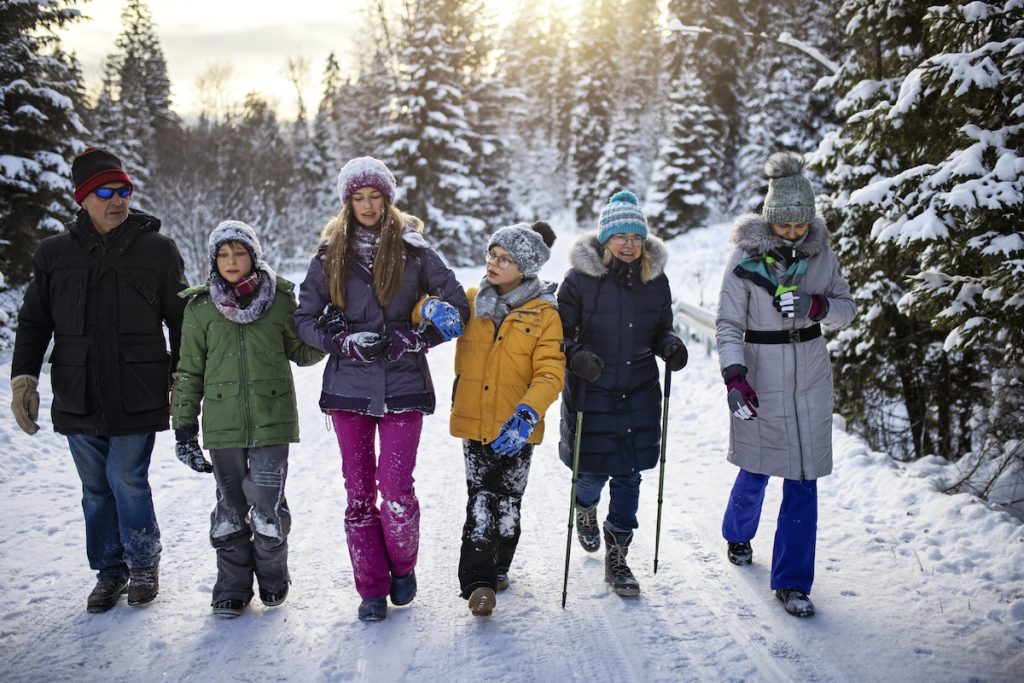How to Enjoy the Outdoors in Winter
5 min read
During the short, cold winter days, it’s even more important to care for your mind and body by getting outside. Hiking and camping are completely possible in the winter with the right preparation, but a short walk in a park to enjoy the winter scenery is just as beneficial. Here’s how to prepare — and enjoy! — an outdoor excursion on a cold winter day.
Dress for the Weather
The right gear can make or break a winter excursion, and dressing correctly for the cold weather is key. As a rule of thumb, cover any skin that’s exposed, or carry extra clothes to do so later on if necessary (a hat, gloves, neck gaiter or scarf, etc.). A pair of waterproof shoes is also essential for winter hiking, snowshoeing, or enjoying a local nature trail.
In the winter, layering is crucial — you might feel really cold for the first half mile, but a hard hike could make you break a sweat halfway through. A three-layer system gives you the freedom to add and lose layers as needed: a base layer close to the skin that wicks away perspiration (like a long-sleeve shirt and leggings), an insulating mid layer (hiking pants and a fleece), and a waterproof shell layer to keep the moisture out (winter jacket and snowpants, if needed). Kids under five are usually best off with a full-body snowsuit in cold, snowy conditions.
The fabric of your clothing matters too. When it gets wet from sweat or precipitation, cotton loses its ability to insulate, and also traps moisture against the skin, which can cool the body down and possibly lead to hypothermia (hence the hiking motto “cotton kills”). Choose items made from breathable fabric that wicks moisture away from the skin instead, like merino wool, polyester, and nylon.
Get the Right Gear
Besides clothing, other winter accessories can make a day outdoors more enjoyable, especially in the ice and snow. When in doubt, bring more than you think you need. If you think there might be icy sections of the trail, toss a pair of microspikes or crampons in your bag. Even if you’re not in the habit of using them in warmer weather, trekking poles can be very helpful with slick, icy terrain.
For overnight or highly specialized activities — like backpacking, climbing, or camping — there will be more winter-specific gear requirements for a safe trip. Consult REI’s winter camping and backpacking tips, and how to look for gear ratings when choosing winter-weather equipment. For example, a sleeping pad that works perfectly in the summer might not protect your body from the cold forest floor in the winter.
All of this winter gear can be expensive, so check out secondhand outdoor retailers or borrow whatever materials you can.
Take Advantage of Better Weather
When the conditions are right, take advantage! Sunny days with minimal wind make for a more mellow winter excursion — especially if you’re getting outdoors with kids, or don’t feel prepared for super cold weather. Look at the weather ahead of time, and plan a trip for a day with milder conditions.
Be (Extra) Prepared
Besides grabbing all the right gear, make sure you’re prepared in other ways too.
Consider your transportation method, and how you’ll access the trailhead or other outdoor location: will your vehicle be able to get you there safely? When going out with a group, coordinate transportation with the car best-suited for icy conditions or treacherous terrain.
If you’re heading to a nature preserve or state/national park, check their website beforehand, which will warn you of any seasonal closings, or if extreme weather has made a trail inaccessible or hazardous. Even when open and available to visitors, trail conditions might be adverse or ill-suited to the needs of your group. Consult apps like AllTrails, where users can leave reviews of trails, or even refer to photos on Instagram tagged at the location to see what the terrain looks like from people who have recently visited. It can often be harder to follow snow-covered trails in the winter, and it’s easy to get disoriented, so have maps downloaded and handy. If you’re accessing maps on your phone, be sure to bring a portable charger too.
As always, have a first aid kit ready in case of emergency — especially in precarious winter terrain.
Try a New Activity
Yes, winter outdoor activities might feel unfamiliar at first, but colder weather brings a great opportunity to try something new! Snowshoeing, cross-country skiing, and winter hiking require minimal equipment that can often be rented at local outdoor stores or larger chains. Take some time to learn about a new activity beforehand: watch instructional videos, learn from friends, or take an online or in-person course before getting out there. If you feel uncomfortable on your own, research group outings with your school, local clubs, or larger organizations like REI, which lead frequent outdoor trips.
Keep It Short and Sweet
Modify your expectations for outdoor activity in the winter — an eight-mile trek in snowshoes is very different from an eight-mile hike in the summer. But a long, remote hike isn’t required for spending some time outside — any amount of outdoor exposure during the winter months is beneficial. A 2019 study found that spending just two hours in nature every week has notable benefits for health and overall well-being, so even short walks around the neighborhood are beneficial. If you can’t access a trail or collect all of the necessary gear, walking through a local nature preserve or urban park to appreciate the sights and sounds can be just as valuable to the body and the mind.
Stay Hydrated and Nourished
In moderate temperatures, the average person needs half a liter of water per hour of activity. You might not expect to need as much water in the winter as you do in the summer, but your body is still working hard. An insulated thermos of tea or hot chocolate is always a good halfway-point pick-me-up too.
The body uses a lot of energy when exercising in the cold, so be sure to bring snacks and have them easily accessible — you don’t want to be standing around in the cold digging them out of the bottom of your pack.
Appreciate Winter Nature!
The leaves might have fallen from the trees, and the ground may be a little less green, but a winter landscape is still full of life. Take winter as an opportunity to learn how to track animals, identify birds, and appreciate winter landscapes. Plus, you’ll probably have fewer people to share the trail with, and you can enjoy the quietness and serenity of a winter day without the crowds.





